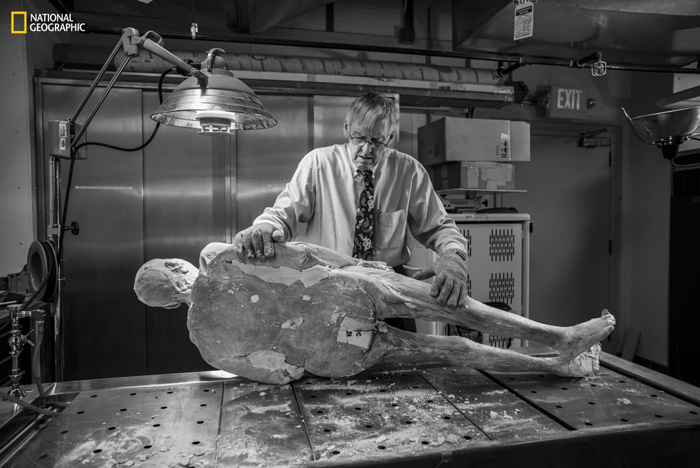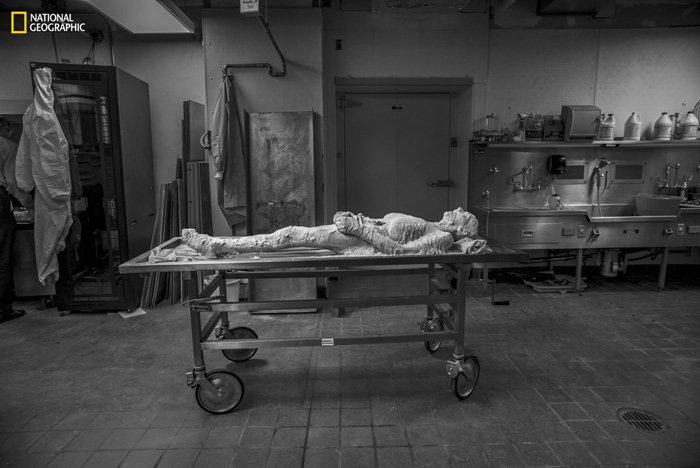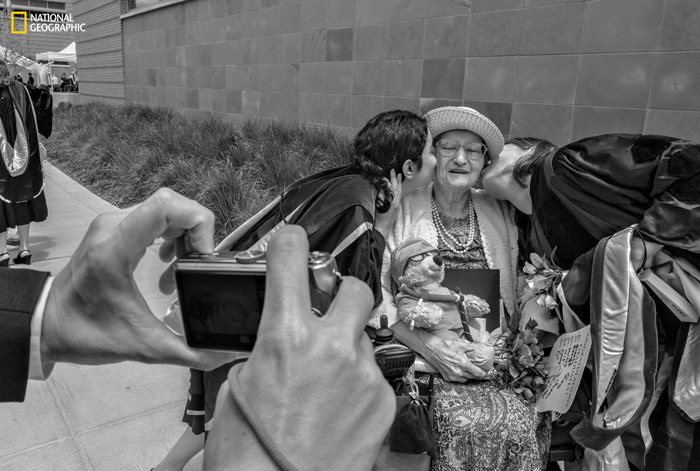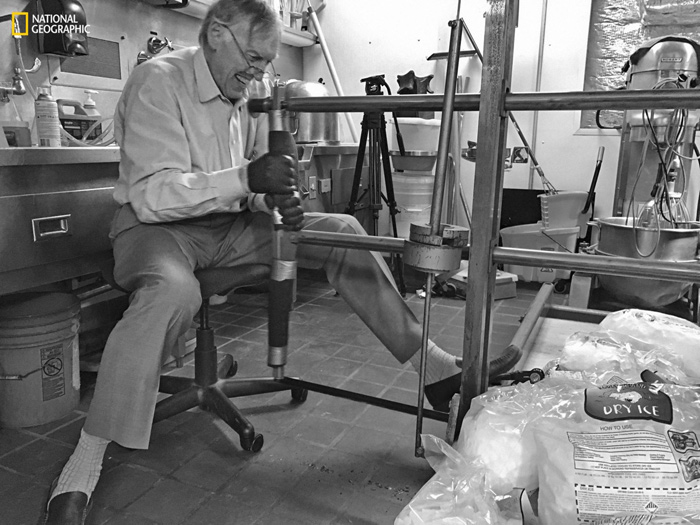87岁老妇为科研“献身” 遗体被切成27000块薄片 This 87-year-old woman donated her body so doctors could slice It into 27,000 pieces
中国日报网 2019-01-21 09:00

很多人都不能接受遗体捐献,但一名87岁的美国老妇不仅捐出了自己的遗体,还做出了一个大胆的决定。在老妇离世后,她的遗体在冷冻后被切成比头发丝还纤细的27000块薄片,每一片的生物信息都被记录下来保存在数据库中,成为不朽的“数字遗体”。

Credit: Lynn Johnson/National Geographic
Susan Potter knew before she died that she, or at least her body, would make history: Not only would hers be the first diseased cadaver (and one containing a titanium hip) to be frozen, sliced up and digitized for all to study, but she also came with a detailed backstory.
苏珊·波特在去世前就知道了,她,更确切的说是她的身体,会创造历史:她的遗体不仅将成为第一个被冷冻、切片并被数字化以用于研究的患病遗体(附带一个钛合金的髋部),还会有一个详细的背景解说。
That's because the Texas woman, when she proposed to doctors that her body be immortalized for medical students, thought she would die in the near future. She lived another 15 years, during which every bit of her life was documented.
这位来自美国德克萨斯州的老妇人,在自认为不久于人世时向医生提议,让她的身体在医学研究中得到永生。在那以后她又活了15年,在这期间她生命中的点点滴滴都被记录了下来。
Potter is the subject of a profile published as part of the upcoming January 2019 issue of National Geographic. The profile focuses on Potter, her personality and what drove her to become, as the author of the story called her, "an immortal corpse." And, unusually, Potter's personality will also be part of how future medical students encounter her corpse.
波特是《国家地理》杂志2019年1月刊人物特辑的主角,其中介绍了她的性格,及成为“不朽遗体”的历程。而且,与以往不同的是,波特的性格也将成为今后的医学生们对她遗体的研究的一部分。
The slicing-her-up-into-27,000-pieces bit is a purely practical project. Those pieces, each three times too thin for a human eye to detect its edge, have since been scanned into a computer, forming a kind of scrollable digital record of her body at the time of death.
将遗体切成27000片则是一个纯粹出于实用目的的项目。那些即使放大三倍也无法用肉眼辨别边缘的薄片被扫描到计算机中,构成了波特死亡时可滚动的数字记录。

Credit: Lynn Johnson/National Geographic
It's now part of the Visible Human Project, an effort to create digital cadavers that students can dissect on their computer screens, over and over again. But unlike previous cadavers in the project, Potter's will come with video recordings of her in life, talking about her illnesses and the medical decisions that left their marks on her body.
这是“可视化人体项目”的一部分,这项计划旨在创造“数字化遗体”,以便于医学生们能够通过电脑屏幕反复地进行细致研究。但是不同于项目中以往记录的遗体,波特的记录还附有她在世时的录像,录像中她谈论了她的病情及各种医疗方案在她身上留下的“印记”。
cadaver[kə'dævɚ]: n. [医] 遗体;死尸
Potter wasn't the first person recorded into the Visible Human Project library, as National Geographic reported. That accolade goes to Joseph Paul Jernigan, a 39-year-old man chosen because he died unnaturally, executed by the state of Texas. So his remains made for a good example of a healthy-seeming body, unusual among people in a position to donate their corpses to medical science. He was chopped into just 2,000 slices, each a millimeter thick, in 1993. A second, 59-year-old female, her name unknown, was chopped into 5,000 0.33-mm slices a year later, after she died of heart disease.
根据《国家地理》的报道,波特并非“可视化人体项目”中的第一人,这个称号归于约瑟夫·保罗·杰尼根,一位在得克萨斯州被处决的39岁男性。不同于那些捐献给医疗研究的遗体,他是非自然死亡的,所以他的遗体是健康的人体样本。该男子在1993年被切割成2000片1毫米厚度的薄片。第二位参加该项目的是一位59岁的不知名女性,在因心脏病去世后的一年,被切割成5000片0.33毫米厚的薄片。
accolade['ækəled]: n. 荣誉
National Geographic's story is about how Potter, who had been through "a double mastectomy, melanoma, spine surgery, diabetes, a hip replacement and ulcers," talked her way into being part of a second phase of the project, one its leaders weren't sure would even happen: the inclusion of a diseased body in the database.
《国家地理》中波特的故事讲述了她如何挺过“双乳切除手术、黑色素瘤、脊椎手术、糖尿病、髋关节置换手术及溃疡病”,还有她如何成为项目第二阶段的一员。项目的负责人原本并没有想过把一具患病的遗体记录到数据库中。

Credit: Lynn Johnson/National Geographic
Potter first approached the Visible Human Project about inclusion in 2000, National Geographic reported. She didn't think she had long to live.
《国家地理》报道说,波特在2000年第一次接触到“可视化人体项目”,那时她觉得自己时日不多了。
But then she went on to live another 15 years, dying in 2015 at age 87. Over the course of that period, she became close with researchers on the project and medical students similar to those who will eventually study her digital cadaver. And Potter traded that closeness for an incredible level of access to the people and facility that would eventually dismember her body. She insisted on a "top to bottom" tour of the "meat locker" where the slicing and preserving would be done, according to National Geographic. That tour wouldn't have been for the faint of heart.
但在那之后,她又活了15年,在2015年以87岁高龄去世。在这段时间中,她与这个项目的研究人员和医学生们有了密切的接触,这种“亲密关系”使她接触到了那些一般人无法接触到的、也是最后将她变成薄片的人和设备。波特还坚持到进行遗体切片和保存的遗体冷藏室进行了一次完整的“深度游”。这可不是心理脆弱的人能做到的。

Credit: Lynn Johnson/National Geographic
After her death of pneumonia on February 15, 2015, doctors recovered her body from the hospice where she died and placed it into a freezer that dipped to minus 15 degrees Fahrenheit (minus 26 degrees Celsius).
2015年2月15日在波特因肺炎去世后,研究人员从临终关怀医院获取她的遗体,将它放入零下26摄氏度的冰柜中。
hospice['hɑspɪs]: n. 临终关怀医院
They would have had to work fast; Potter carried a card at all times notifying whoever found her body that they had just four hours to get it frozen for the preservation to work. Potter remained in that freezer for two years. Then came the laborious work of cutting and imaging the slices. The first step involved a "two-person crosscut saw" to divide her 5' 1" (155 centimeter) frame into quarters. Then a precision cutter further reduce those quarters to individual slices for imaging.
他们必须要动作迅速,波特一直随身带着小卡片,上面清楚告知任何人在拿到遗体的四小时内务必要将它冷冻保存好。波特在冰柜里呆了两年,接下来就是艰巨的切片及成像工作。第一步要使用一种“双人横切锯”将1米55的她分割成块,接着再进一步将这些尸块切割成薄片用于扫描成像。

Credit: Lynn Johnson/National Geographic
You can read the full article on Potter, her life and her cadaver here, as part of National Geographic's January 2019 special single topic issue, The Future of Medicine.
在《国家地理》2019年1月刊特辑《医学的未来》中,你能够读到关于波特的人生和她的遗体的完整文章。
来源:趣味科学网、煎蛋网
编译:丹妮

















 英语点津微信
英语点津微信 双语小程序
双语小程序